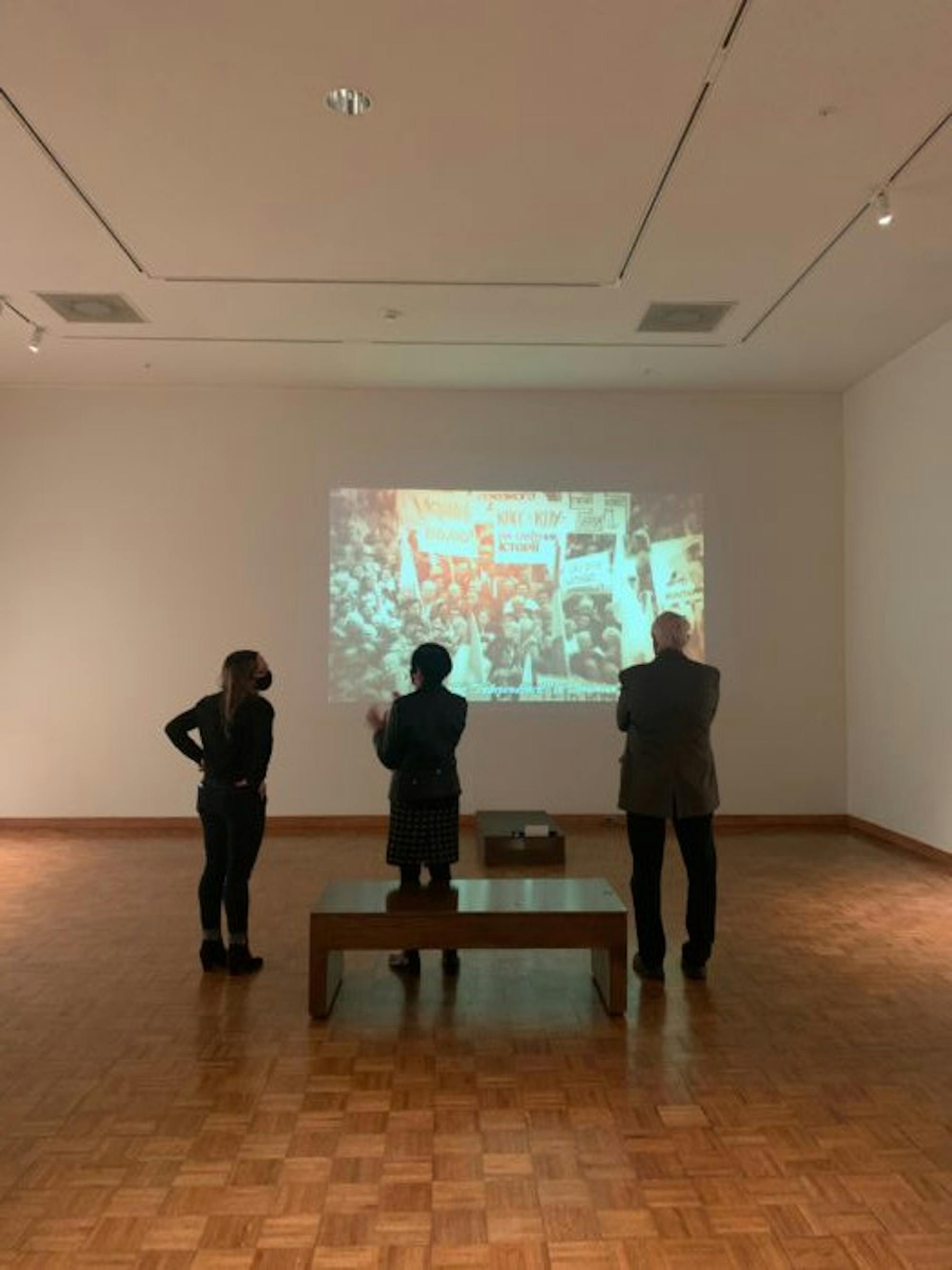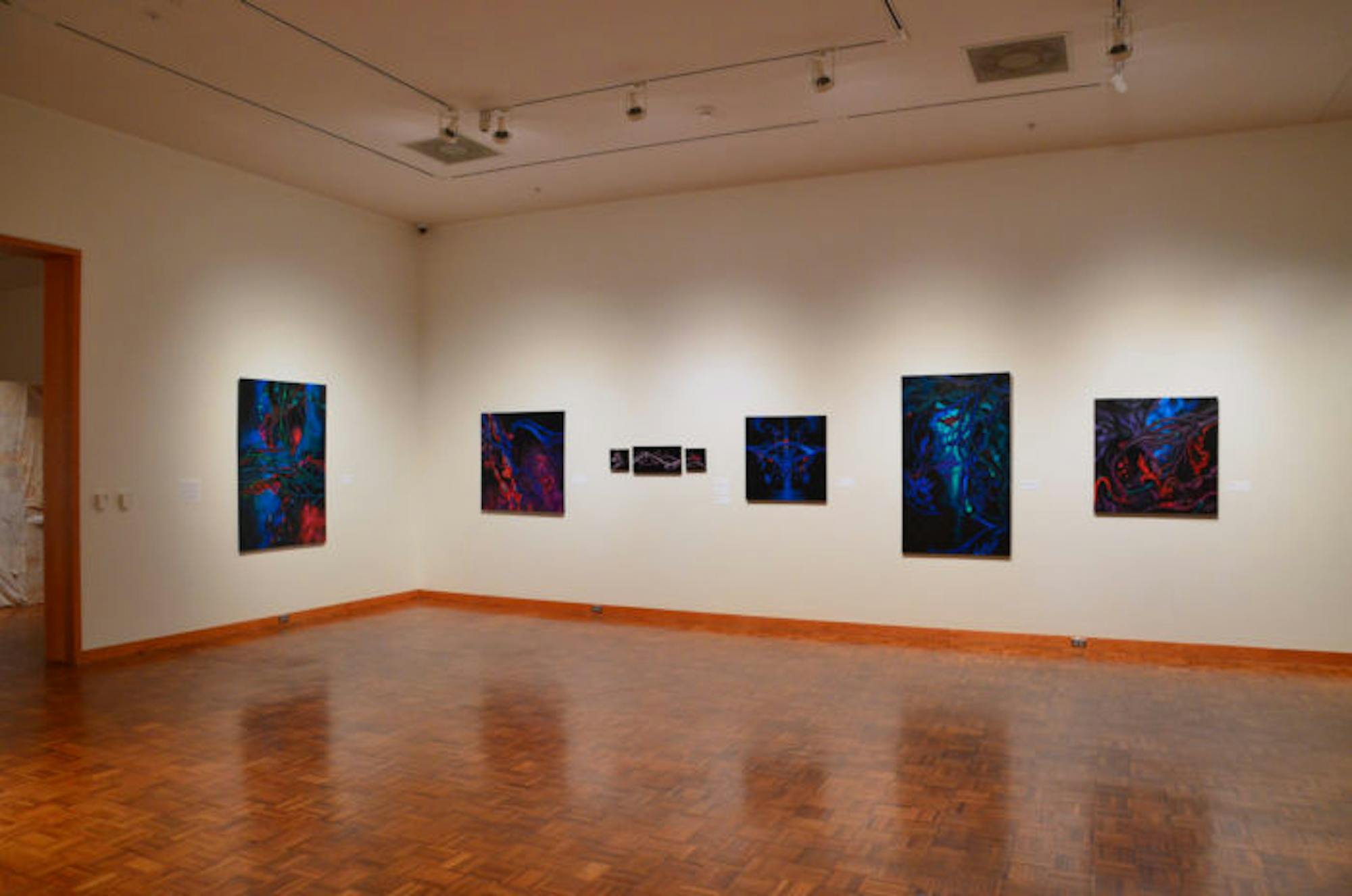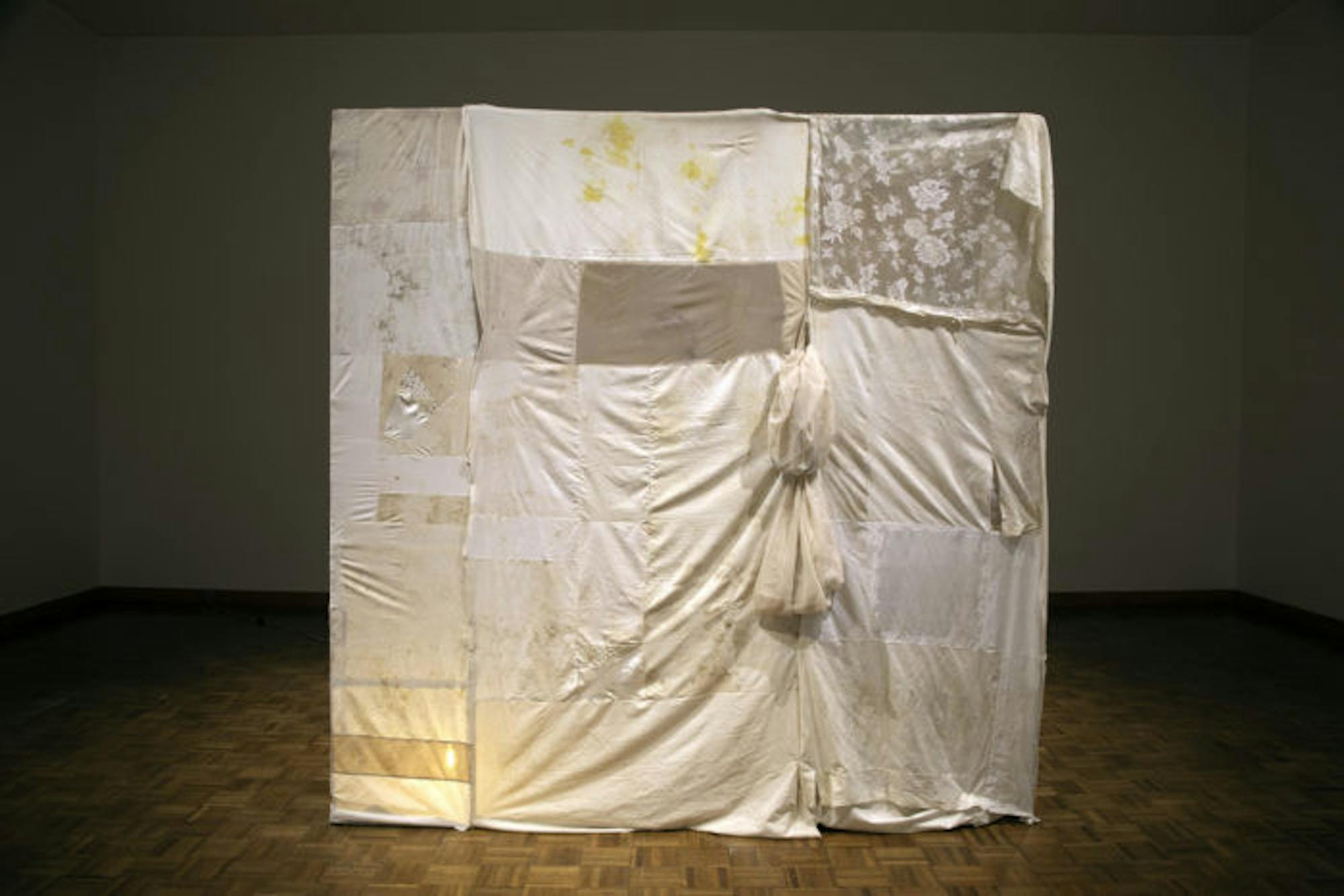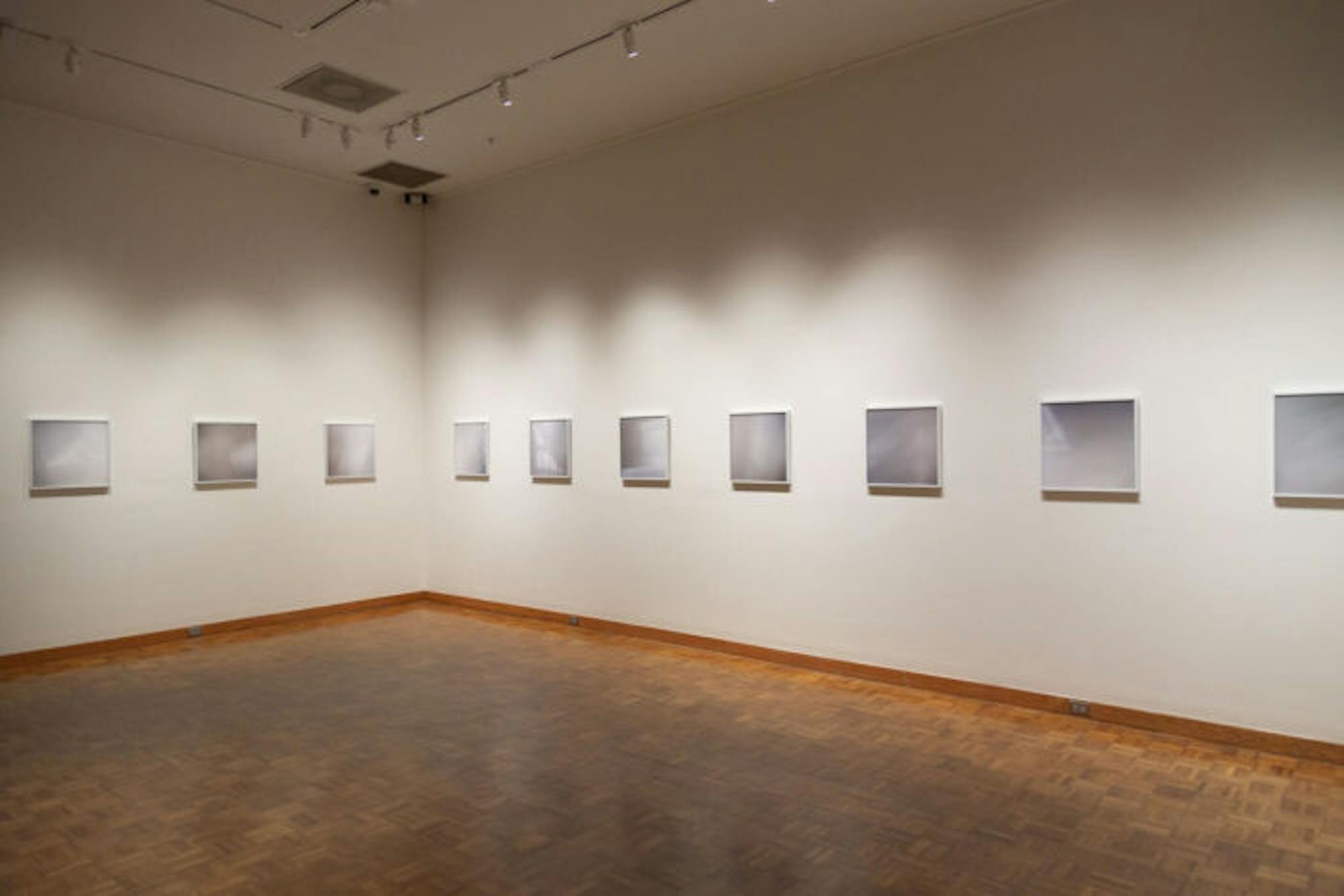Each year, Notre Dame graduate students in the Master of Fine Arts (MFA) program present their final thesis projects. This year, students completed projects in visual communication design, photography, industrial design, painting, sculpture, ceramics and industrial design.
These artists researched and worked on their projects throughout the three-year program, and their theses will be on temporary display for the tri-campus community in the O’Shaughnessy Galleries of the Snite Museum of Art during normal operating hours.
Visual Communications Design: “Witness Eugenia” by Yuliya Fedorovych
Fulbright Scholar and Ukrainian native Yuliya Fedorovych completed her thesis project in the visual communications design category.
She began working on the film itself in September 2020, devoting a large portion of her time to researching her topic — the mass Ukrainian genocide carried out under Stalin between 1932 and 1933, otherwise known as Holodomor, which roughly translates to “kill by starvation.” The genocide took the lives of at least four million Ukrainians.
According to her artist’s statement, Fedorovych’s short film tells the story of Eugenia Sakevych Dallas, a Holodomor survivor who later became a successful model. The film deconstructs historical and personal photographs, pairing them with hand-drawn elements to recreate Eugenia’s story, the artist’s statement said.
[gallery type="square" ids="226615,226616,226617,226618,226619"]
Fedorovych said she considered several mediums for the project, including an interactive game or a website, but decided a film would be best to convey her message.
“I arrived with this decision that film would be the best because it’s very easy to share online via social media,” Fedorovych said. “I also want [the film] to be really accessible and engaging.”
The hope of the piece is to encourage American young adults to be aware of these issues and understand the history, Fedorovych said.
“I feel like that’s [Holodomor] a really big issue, especially because it was concealed from the world for 50 years. It was not properly investigated. Even for me, this famine is a very big wound,” Fedorovych said. “This is such an important thing for me and I’m sure for other Ukrainians, but in the U.S. people just have no clue that this happened.”
She also said that the number of Soviet regime victims — including Ukrainians who endured Holodomor — were far greater than Nazi regime victims.
In creating the film, Fedorovych said she used specific strategies to make the approximately 20 minute film serious yet uplifting.
The film “not only communicates the atrocities of genocide, but it also uplifts the viewer, so you don’t feel traumatized. I try to provide my audience with the opportunity to make sense of what they just saw.”
In order to turn these feelings into positive actions, Fedorovych said she collects donations to help expand the Holomodor Genocide Museum in Ukraine. Every donation helps the museum better honor the victims, discover their names and prevent similar future tragedies.
The Snite awarded Fedorovych’s video the Walter R. Beardsley Endowment for Contemporary Art Prize, which includes a $1,000 dollar prize.
Fedorovych said she was surprised to receive the award and is in the process of donating that money to the Holomodor Genocide Museum.
Painting: “Into the Chthulucene” by Ana Fleming
According to her artist statement, Ana Fleming’s work, inspired by genres of speculative or weird fiction, portrays “a tentacular space of multispecies interactions, tensions, and possibilities” via oil paint and charcoal drawing.
The term “Chthulucene” is a term from author Donna Haraway that refers to “an ecological way of thinking and sort of futuristic time, space and conceptual mode,” Fleming said.
Since she pursued an undergraduate degree in English, Fleming said literature and reading still informs much of her thinking about art. She said she never expected to pursue a master’s degree in art but is pleased with her decision.
“I’m really happy I did [the MFA program]. I’ve loved my experience here, and this is the first portion of my life where I’ve been able to sort of exclusively dedicate myself to the production of art.” she said.
Her paintings feature “entwining, outreaching tentacles [that] sprawl and latch; forms and bodies interlock and reverberate in dynamic becomings-with, all threads in a complex tapestry of matter,” she wrote in her artist’s statement.
Fleming said that oil painting works well for her thesis because of its capacity for bright colors and immersive qualities.
“Thinking about these speculative environments with really rich colors, highly saturated palates, oil paint is perfect for that because it’s very highly pigmented. You can layer it through glazing techniques and achieve really striking color, which was important for communicating the kind of alien quality of these worlds,” she said.
[gallery type="columns" ids="226577,226579,226580,226578"]
In terms of her intentions with the paintings, Fleming said the ecological crisis played a role in the purpose of her work.
“You can’t always anticipate what someone’s going to think or how they’re going to react,” Fleming said. “But certainly, part of what motivates me to make the paintings is my interest in the ecological crisis that we’re confronted with right now.”
Additionally, her work strives to create a world where humans are not central.
“I like to shift the point of view from a human-centered one to thinking about the non-human world in all its different capacities, microscopic worlds, nonliving systems,” Fleming said.
Fleming acknowledged that every viewer will take away something different from the painting and drawings, but she hopes her thesis can encourage critical thinking about these topics.
“There are a lot of ideas there, but if people can even just think about a little piece of that equation, then I think that will be successful,” Fleming said. “I view art as a way to spur thinking ... hopefully people can have an emotional reaction to the paintings and maybe use that as a way to rethink how they move through the world.”
Ceramics: “On borrowing” by Jennifer Kaplan
Before entering the Master of Fine Arts program, Kaplan taught ceramics in Chicago. Three years of research and intellectual strain later, she has completed her thesis work.
“When you’re getting an MFA, it’s not quite like other departments where there’s a right answer,” Kaplan said. “You’re really trying to find your own path and figure out what you care about and come up with the visual language to express those things.”
Despite the mental gymnastics of her last three years, Kaplan pinpointed one moment — reading the book “Braiding Sweetgrass” by Robin Wall Kimmerer — as extremely clarifying for her work and her connection to clay.
Kaplan said she enjoys ceramics because it lacks “form permanence” in its raw state, meaning it can manipulated again and again before taking on its final shape. She also said working with clay reminds her of spending time with her father.
“I really started using ceramic material clay when I got to hang out with my Dad on Tuesday night[s],” she said. "For he and I, it’s always been this really therapeutic thing.”
This connection with her dad is one example of the human interaction Kaplan hopes to convey through her work.
[gallery type="square" size="medium" ids="226462,226472,226459,226460,226475,226464,226465,226461,226471,226469,226476,226467"]
Speaking to the theme of connection expressed in her thesis, Kaplan said, “We’re sort of always in this highly entangled web of borrowing each other, sort of consuming one another, and through this work, I’m asking people to be a bit more mindful about how they’re doing that.”
Kaplan purposely compiled pieces from various collections to represent the diversity of interaction and connection.
“The pieces that are in the Snite I made all within the last year and have sort of pared down, just these little samples of these moments,” Kaplan said. “I kind of tried to create this entire family or community of pieces, and then sort of select them down so that those few were having a conversation.”
Industrial Design: “Aegis” by Milagros Ramirez
For the industrial design thesis, Milagros Ramirez created a design for a breast pumping tower intended for sale to enterprises.
“The intent is for companies to showcase their support for working mothers who pump,” Ramirez said.
[gallery type="rectangular" ids="226621,226622"]
In her research, Ramirez discovered many short-term and long-term benefits to providing children breast milk and wanted to help solve one problem new mothers face when returning to work.
“It’s critical for a mother to feed her infant breast milk, especially the first six months of life, because it contains a bunch of nutrients that [have] long-term and short-term life effects,” Ramirez said.
After completing her thesis, Ramirez said she plans to pursue a career in banking; however, she enjoyed the artistic opportunity provided by the MFA program, which allowed her to design a theoretical product without necessarily executing the plan in physical reality.
“I always had a passion for the art side and the engineering side,” Ramirez said. “The idea of just generating concepts is compelling to me.”
Sculpture: “House” by Cassandra Schifano
Cassandra Schifano is a Midwest fiber artist who works primarily with sculptural fabrics. For her MFA thesis, she explored several aspects of memory through her fabric sculpture.
Specifically, Schifano’s thesis communicates the complexity and loss of memory.
“The goal ultimately is to create a space for the viewer to consider their own relationship to the potential loss inherent in their memories,” Schifano said in her artist statement. “Memory existing as an unknowable preservable trace; an excessive substance; a way we collect our past, and what we base so much of lives and deaths upon. This is the space that I am creating.”
Schifano said she chose a fabric medium because of its connective properties and domestic implications.
“I use fabric as a connective medium because it naturally suggests memory as it is embedded with domestic significance and is connected to place and body,” Schifano’s artist statement said.
In an email, she also said that relocating the project outdoors during the COVID pandemic changed her course.
“Taking the project outside during spring 2020, when we lost access to the studios due to Covid, really made me consider how light (from the sun) penetrates the fabric and changed how I decided to light the piece in the gallery,” Schifano said.
Photography: “Luminous Visions” by Anna Thorne
With a slightly unconventional start to graduate school, Anna Thorne said she joined the MFA program after having a dream about fine arts at Notre Dame — a program she said she did not know existed beforehand.
“I honestly didn’t know that Notre Dame had an art program, and of course after that dream I was like, ‘Okay, I’m going to look this up,’ and it ended up being such a perfect fit,” Thorne said.
Completing her thesis in photography, Thorne’s work is made up of a series of lenticular photographs, images that are cold-laminated underneath a laser-etched sheet of polyester to provide the illusion of movement.
[gallery type="columns" ids="226645,226646,226647,226648,226649,226650,226651,226652,226653,226654"]
Thorne’s photographs, all documentations of natural light in interior spaces, aim to induce a mindful state in the viewer.
“Immersion into the present moment through mindful observation burns away the mental fog of our day to day thoughts and emotions to reveal an ineffable realm of clarity,” Thorne wrote in her artist’s statement. “‘Luminous Visions’ draws us into the boundless unfolding of presence, a state of being that exists unburdened by our human impulse of interpretation and meaning.”
Thorne said her interest in photography began at a young age, and she chose to use photography for this project because of its attempts and failures to represent the present.
“A photograph refers to a depicted subject matter while also being an original visual experience,” Thorne said. “I like to use photographs, particularly because they relate to the idea that the present moment is all we ever have. That right here and now is this ever-elongating moment that extends from the past into the future.”
Like her fellow MFA students, Thorne said the pandemic impacted her process. After visiting California for spring break, Thorne could not return to the University, and remaining inside for nearly every hour of the day gave her many opportunities to observe and capture natural light in interior spaces.
“It [the pandemic] actually helped my work, because all of this thesis work is photographs of natural light in interior spaces,” Thorne said. “This is the perfect opportunity to use it as like a meditative exercise. Instead of being anxious and worried, I just decided to use my camera as a way to slow down, to pay attention to the natural light happening in the house.”
In the future, Thorne said she hopes to quadruple the size of these images to further immerse the viewer in a meditative state of mind.
MFA students present final thesis projects in Snite museum
“The Holodomor was one of the largest genocides of the 20th century in terms of its death toll and has left scars on the people of Ukraine,” Fedorovych wrote in her artist’s statement. “The perpetrators of this genocide never faced justice and the full extent of the tragedy is largely unknown to the world.”
Fleming’s thesis paintings, along with her peers’, are currently displayed in a special gallery in the Snite Museum of Art.
“Pollinator Pod,” one of Kaplan’s sculptures, invites participation and cooperation between people and nature, as Kaplan will display the sculpture outside after the exhibition and encourage viewers to take one of the ceramic-coated seeds.
In her artist’s statement, Schifano said she created the piece through labor-intensive sewing processes and fabricated architectural construction.
“The bond between photography and daily life invites us to recognize the simple presence of natural light appearing in our own everyday environments,” Thorne’s artist statement says.









